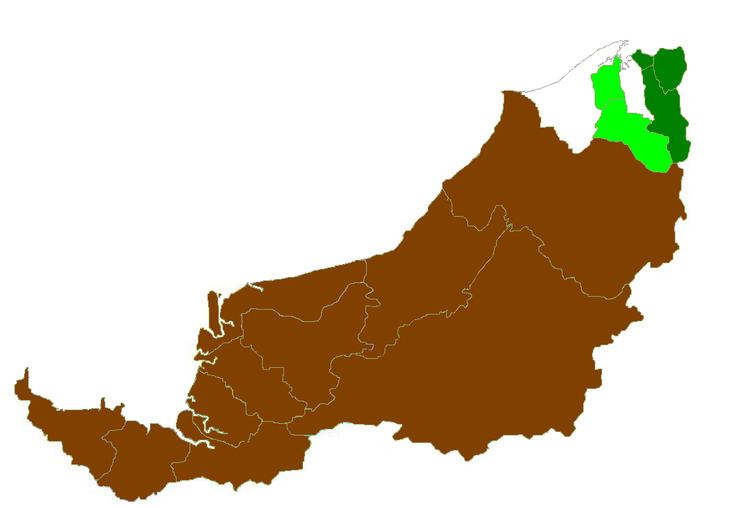District Officer Anyi Ngau Population 40,959 (2000) | Local area government(s) Majlis Daerah Limbang Area 3,977 km² | |
 | ||
Ethnicity Bruneian Malay and Kedayan (30.3%), Iban (24.7%), Chinese (21.3%), Others (23.7%) | ||
The Limbang District is one of the two districts of Limbang Division, Malaysia. It has a total area of 3,976.00 square kilometres. The major town is Limbang. It has one sub-district, which is Nanga Medamit. It borders Brunei Darussalam to the west and east, Lawas District to the southeast and Miri District at the south and southwest. Due to being squeezed in between Brunei Darussalam at its north and coastal areas, Limbang is accessible by road only by going through immigration posts. According to history, this area was annexed by Charles Anthoni Johnson Brooke, the second Rajah of Sarawak in 1890 from Brunei to become the fifth division of Sarawak. The annexation was strongly disputed by Brunei.
Contents
The de facto boundary ran along the watershed between the Brunei River and Limbang River basins on the western side of the district, and along the length of the Pandaruan River on the eastern side. Boundary agreements have delineated a stretch of the western border and the Pandaruan River while the other stretches have yet to be delineated.
Limbang area is claimed since 1967 by Brunei as part of its integral territory. The issue was said to have been settled in 2009 as been stated from Bruneian media. However, Bruneian Second Minister of Foreign Affairs and Trade Lim Jock Seng said the issue was never been discussed during the meeting of both countries leaders.
Demography
The population of Limbang district (year 2000) was 40,959.
Ethnicity
Limbang is traditionally a home to Bruneian Malay, Kedayan, Chinese, Iban and Orang Ulu people.
Limbang is the most culturally diverse and distinct part of Sarawak. It is a melting pot of many cultures, including Malay, Kedayan, Chinese, Iban and various Orang Ulu ethnic groups such as Lun Bawang, Bisaya, Murut, Kelabit and Penan. It has one of the highest concentration of Orang Ulu people in Sarawak.
Note:
1 Excluding Kedayan.
2 Including Kedayan and other Orang Ulu such as Lun Bawang, Kelabit, Penan, Murut etc.
Economy
The economy is largely based on the timber and agricultural industries. Timber industry remains a strong component of the district's economy. Agriculture is relatively minor although growing steadily, with oil palm, rattan and pepper the main products.
Transportation
Owing to its geographical location, Limbang is completely cut off from the rest of Sarawak's road network. It is however has good road links to both parts of Brunei located to the east and west of the district. There is also a good local network of roads in the district.
There are two road border crossing checkpoints in Limbang district, both into Brunei.
Education
Limbang District has five secondary schools: SMK Limbang, SMKA Limbang, SMK Medamit, SMK Seri Patiambun Limbang and SMK Kubong. It has numerous primary schools, mostly scattered around Limbang rural areas.
Healthcare
Limbang has its own hospital which is Hospital Limbang. However, as for surgeries and more critical cases, they are normally referred to Miri Hospital, or to greater extent, Sarawak General Hospital in Kuching.
Security
Limbang District has a police district office. There are also police stations and police bits located at strategic locations, as well as rural areas. Despite being the fourth largest division, Limbang Division so far has no district military bases. This is also true for Limbang District. Only small military camps do exist just to make presence at Limbang district.
Government services
Other government offices have set up their branches in Limbang Districts such as Royal Customs, Fire and Rescue Department, Education Department etc.
